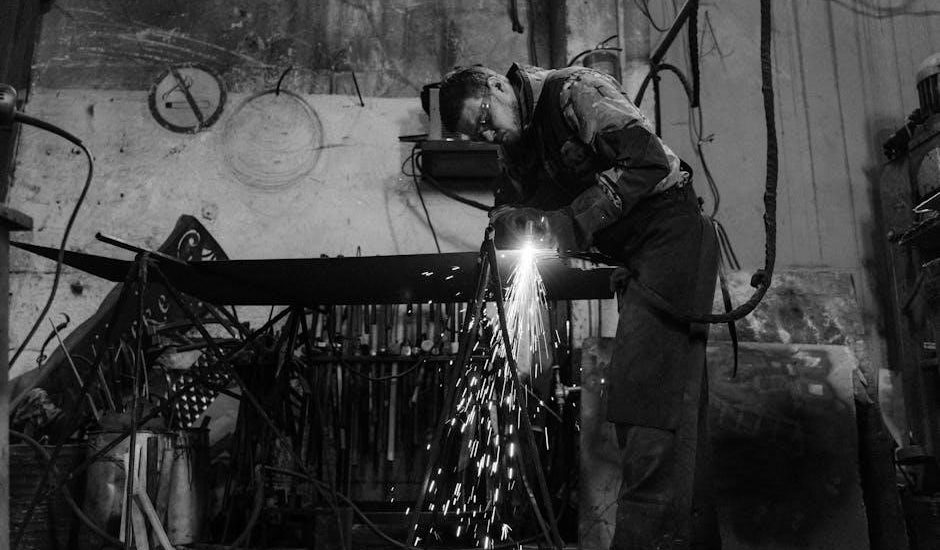Miller welder manuals are comprehensive guides designed to help users operate, maintain, and troubleshoot their welding equipment effectively. These manuals cover essential topics such as safety precautions, setup instructions, and maintenance routines. Available online through Miller’s official website, they provide detailed information to ensure optimal performance and safety. Whether you’re a novice or an experienced welder, these manuals are indispensable resources.
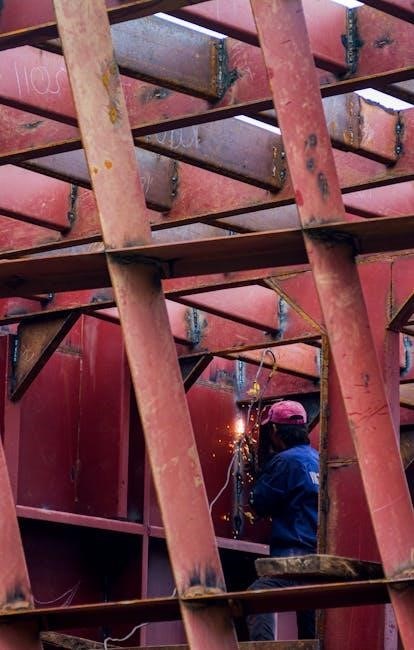
Safety Precautions
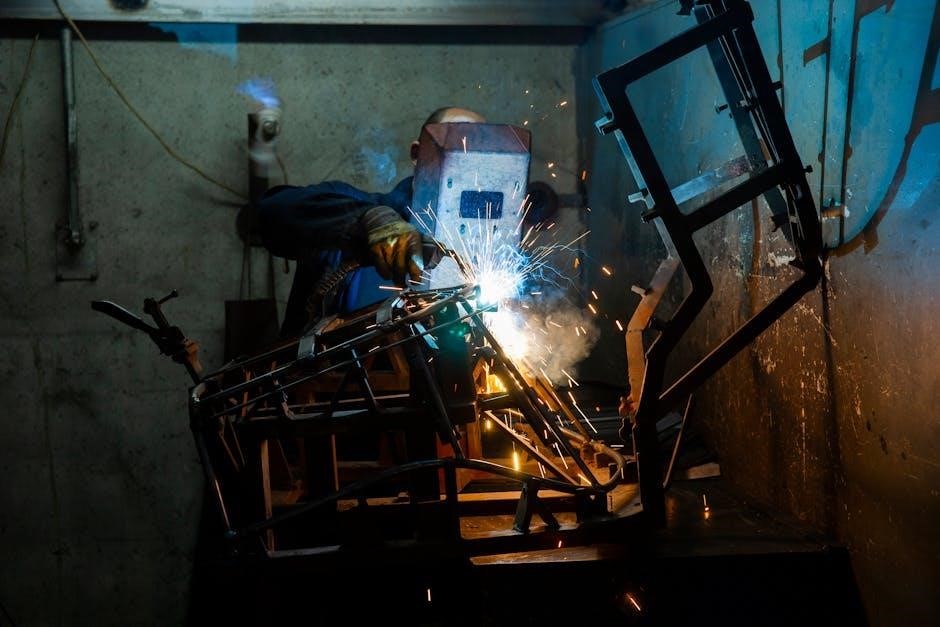
Miller welder manuals emphasize critical safety measures to ensure safe operation. Always adhere to equipment ratings and use appropriate protective gear. Proper workspace setup is essential to prevent hazards. For high-voltage units, specific precautions are necessary. Refer to the manual for detailed guidelines tailored to your welder model to minimize risks and ensure a secure working environment.
2.1 Understanding Equipment Ratings
Understanding equipment ratings is crucial for safe and effective operation of your Miller welder. These ratings, detailed in the manual, specify the maximum voltage, current, and duty cycle your welder can handle. Exceeding these limits can damage the machine or pose safety risks. For instance, high-frequency (HF) equipped units require special precautions due to higher voltages, and Miller’s customer service can provide guidance if needed. Additionally, choosing the right welder type—such as semiautomatic DC, DC manual (stick), or AC welder with reduced open-circuit voltage—ensures compatibility with your welding needs. Always refer to the manual to match your equipment to the job requirements, ensuring optimal performance and safety.
2.2 Personal Protective Equipment
Personal protective equipment (PPE) is essential for safeguarding yourself while operating a Miller welder. The manual emphasizes the importance of wearing appropriate gear to prevent injuries from arc flashes, spatter, and other welding hazards. A welding helmet with a shaded lens is crucial to protect your eyes and face from intense UV radiation and molten metal particles. Additionally, safety glasses or goggles should be worn under the helmet for extra protection.
Miller welder manuals also recommend wearing fire-resistant clothing, including long sleeves, pants, and closed-toe shoes, to minimize the risk of burns from sparks. Insulated, heat-resistant welding gloves are necessary to handle hot equipment and protect your hands from cuts and abrasions. Ensure all PPE fits properly and is free from damage to maintain its protective integrity.
Regularly inspect your PPE for signs of wear or damage, and replace items as needed. Proper use and maintenance of PPE are critical for ensuring your safety during welding operations. By following the guidelines outlined in the manual, you can create a safer working environment and reduce the risk of accidents. Always prioritize PPE to protect yourself from the inherent hazards of welding.
2.3 Proper Workspace Setup
Setting up a proper workspace is crucial for safe and efficient welding with your Miller welder. The manual emphasizes the importance of creating a clean, well-ventilated, and organized work environment. Start by ensuring the workspace is free from flammable materials, such as curtains, wood, or grease, to minimize fire hazards. Keep the area around the welder clear of clutter to prevent tripping or accidental damage to the equipment.
Ventilation is another key consideration. Welding generates fumes and particles that can be harmful if inhaled. Open windows or use a ventilation system to maintain fresh air flow. If possible, invest in a fume extraction system to reduce exposure to harmful substances. Additionally, ensure the workspace is well-lit to improve visibility and reduce eye strain during long welding sessions.
Position the Miller welder on a stable, level surface to ensure consistent performance. Keep the power source and welding leads away from water or moisture to prevent electrical hazards. Secure all cables and hoses to avoid tangling or damage. Organize your tools and materials within easy reach to streamline the welding process and reduce the risk of accidents.
Finally, designate a specific area for storing welding supplies, such as electrodes, shielding gas cylinders, and consumables. Regularly inspect the workspace for potential hazards, such as spills or loose wires, and address them promptly. By following these guidelines, you can create a safe and efficient workspace that complements the performance of your Miller welder.
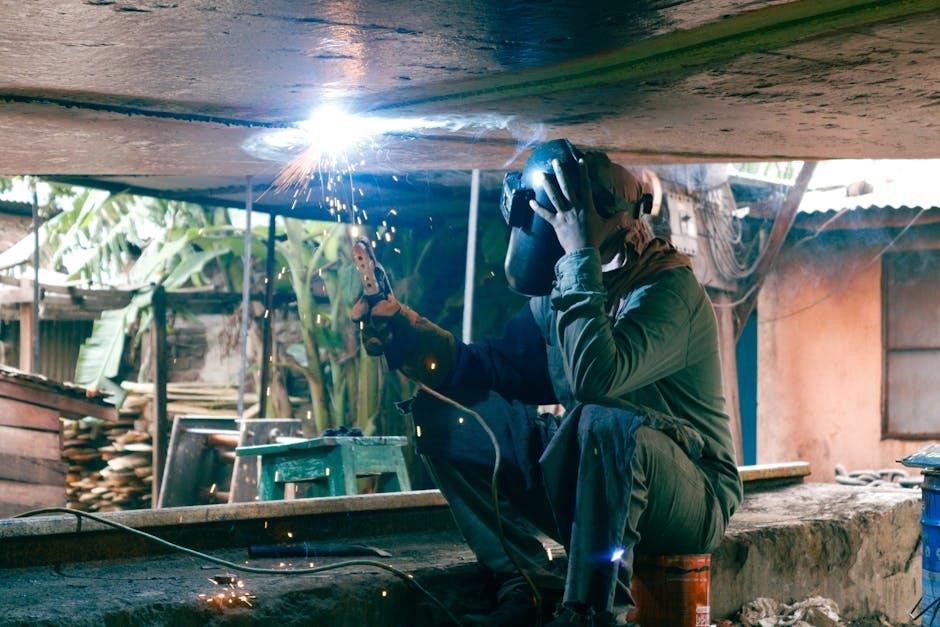
Operating the Miller Welder
Operating the Miller welder requires careful preparation and attention to detail. Begin by powering on the machine and selecting the appropriate welding mode. Adjust the voltage and current settings based on the material thickness and type. Ensure all connections are secure and properly grounded. Monitor the welding process closely, maintaining consistent arc length and travel speed for optimal results. Always follow the manufacturer’s guidelines for specific materials and techniques to achieve professional-quality welds. Use the control panel to fine-tune settings as needed during operation. Keep the welding area clean and free from debris to ensure safety and efficiency. Regularly inspect the welding tip and consumables to maintain performance. By adhering to these operational best practices, you can maximize the capabilities of your Miller welder and produce consistent, high-quality welds.
3.1 Choosing the Right Welding Process
Choosing the right welding process for your Miller welder is essential to achieve desired results. The most common processes include MIG (GMAW), TIG (GTAW), Stick (SMAW), and Flux-Cored welding. Each process has unique advantages and is suited for specific materials and applications. MIG welding is ideal for thin materials like aluminum and steel, offering high-speed and clean results. TIG welding is preferred for precision work, especially on delicate or non-ferrous metals, as it provides exceptional control and quality. Stick welding is versatile for thick materials and outdoor use, while Flux-Cored welding combines the ease of MIG with the penetration of Stick welding.
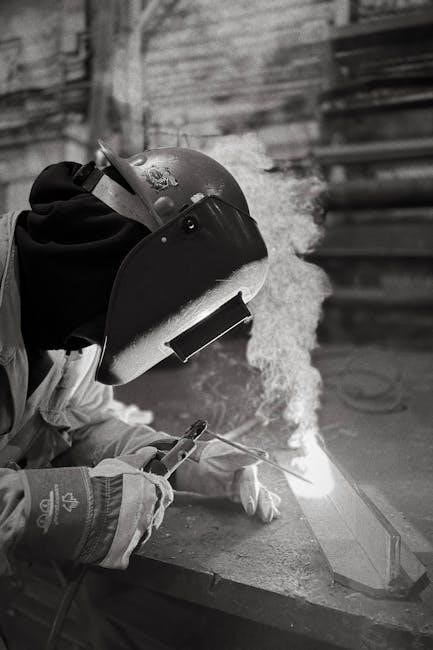
To select the correct process, consider the material type, thickness, and desired weld appearance. For example, aluminum requires TIG or MIG processes, while steel can be welded with any method depending on thickness. Joint design and accessibility also play a role, as TIG welding may require more time and skill for complex joints. Always consult the Miller welder manual for specific settings and recommendations. Proper process selection ensures efficiency, quality, and safety in your welding projects.
3.2 Setting Up the Welder
Setting up your Miller welder correctly is crucial for optimal performance and safety. Begin by carefully unpacking the unit and placing it on a stable, flat surface. Ensure the welder is positioned in a well-ventilated area, away from flammable materials. Connect the power supply according to the voltage requirements specified in the manual, and ensure all cables are securely attached to avoid loose connections.
Next, configure the gas setup if your process requires it (e.g., MIG or TIG welding). Attach the gas cylinder to the welder, ensuring the regulator is properly secured and the gas type matches your welding process. For MIG welding, install the wire spool in the wire feeder, threading the wire through the liner to the torch. For TIG welding, ensure the tungsten electrode is correctly installed and sharpened.
Select the appropriate welding process using the control panel, choosing between MIG, TIG, or Stick modes. Adjust the polarity settings as recommended for your process and material type. Set the voltage and wire feed speed (or amperage for TIG) based on the thickness and type of material you are working with. Refer to the Miller welder manual for specific parameter recommendations.
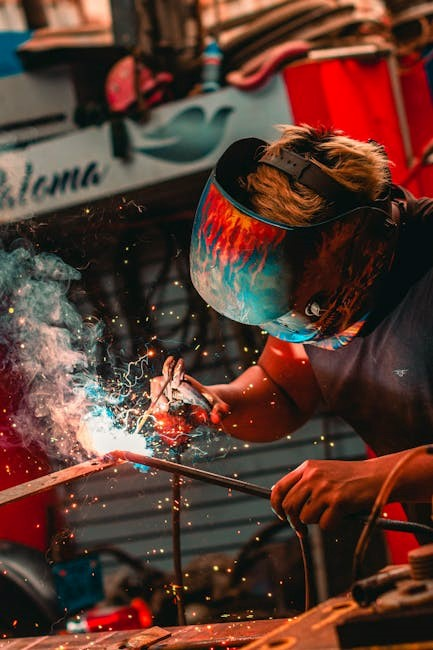
Finally, test the equipment by initiating a small weld on scrap material. Check for proper arc performance, wire feeding, and gas flow. Make any necessary adjustments before beginning your actual welding project. Proper setup ensures consistent results, reduces downtime, and extends the life of your Miller welder. Always double-check your setup to avoid potential issues during welding.
3.3 Understanding the Control Panel
The control panel is the central interface of your Miller welder, allowing you to adjust settings and monitor operations. It is designed to be user-friendly, with clear labels and intuitive controls. The panel typically features a digital display that shows current voltage, amperage, and wire feed speed, making it easy to monitor your welding parameters in real time.
Key components of the control panel include the voltage control knob, amperage adjustment, and wire feed speed selector. These tools enable precise tuning of your welder to match the specific requirements of your project. For example, you can increase or decrease the voltage to achieve the desired arc characteristics, while adjusting the wire feed speed ensures consistent wire delivery during MIG welding.
Many Miller welder models also include a mode selection feature, allowing you to switch between different welding processes such as MIG, TIG, or Stick welding. Some advanced models may offer additional settings, such as pulse welding or synergic controls, which automatically adjust parameters for optimal results. The control panel may also include memory settings, enabling you to save and recall frequently used configurations.
Indicator lights or alarms on the control panel alert you to issues such as overheating, low gas flow, or improper wire feed. Familiarizing yourself with these indicators is essential for troubleshooting and maintaining smooth operation. Always refer to your Miller welder manual for specific guidance on using the control panel features for your particular model.

By mastering the control panel, you can unlock the full potential of your Miller welder, ensuring precise control and consistent results for every welding task.
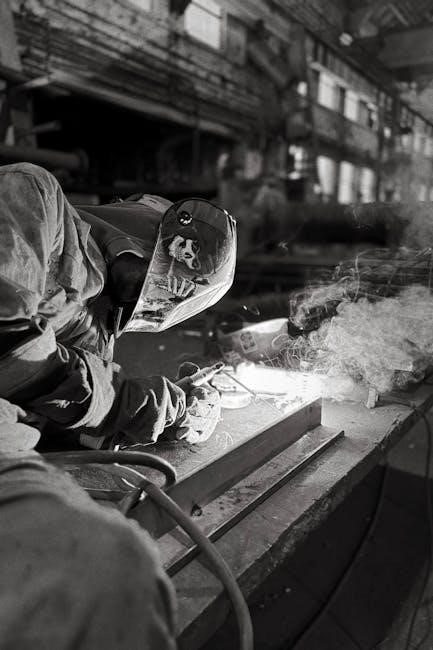
Maintenance and Care
Regular maintenance ensures your Miller welder performs optimally and extends its lifespan. This includes routine cleaning, inspecting parts, and addressing wear. Always follow the manufacturer’s guidelines for care to prevent breakdowns and maintain reliability. Proper storage and handling are also crucial to uphold the welder’s condition and functionality over time.
4.1 Routine Cleaning
Regular cleaning is essential to maintain the performance and longevity of your Miller welder. Start by turning off the power and allowing the machine to cool down completely. Use a soft-bristle brush or a clean cloth to remove dirt, dust, or spatter from the exterior and interior components. Pay special attention to the welder’s vents, as blockages can restrict airflow and cause overheating. For tougher debris, such as dried weld spatter, gently scrape it off using a plastic scraper or a wire brush. Avoid using harsh chemicals or abrasive materials, as they may damage the welder’s finish or components.
Next, inspect and clean the welding gun, torch, and cable. Remove any spatter or residue from the gun’s nozzle and contact tips using a dedicated cleaning tool or a small wire brush. Ensure the gas nozzles are free from obstructions to maintain proper gas flow. For the power source, clean the terminals and connections with a wire brush to prevent corrosion and ensure good electrical conductivity.
Finally, wipe down the entire machine with a damp cloth to remove any remaining dust or grime. Regular cleaning not only prevents wear and tear but also ensures consistent welding performance. Always refer to the Miller welder manual for specific cleaning recommendations tailored to your model. By incorporating routine cleaning into your maintenance schedule, you can keep your welder in excellent working condition and avoid costly repairs down the line;
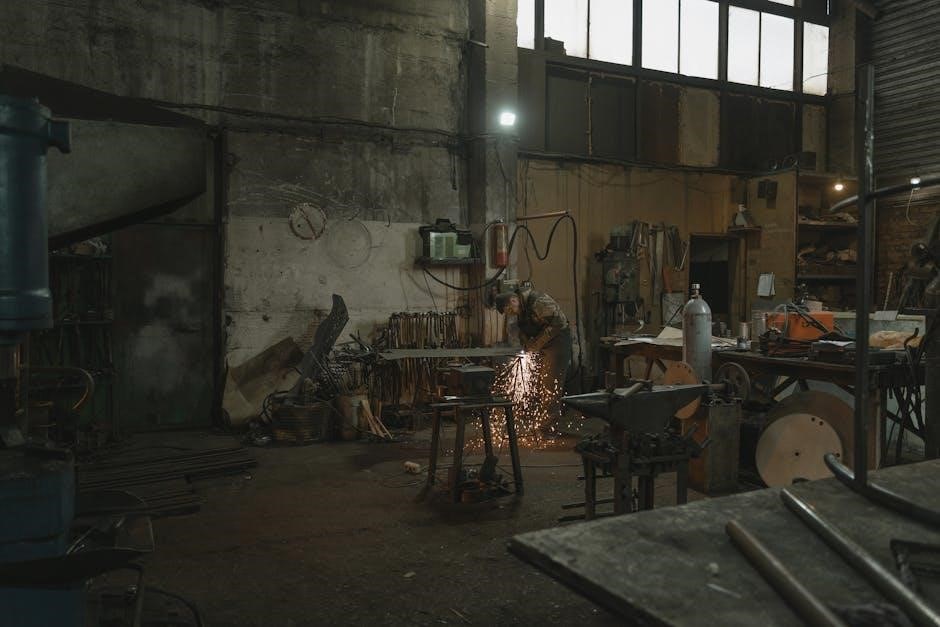
4.2 Replacing Parts
Replacing parts on your Miller welder is essential to uphold its performance and extend its lifespan. Over time, components like contact tips, nozzles, and welding cables may wear out or become damaged, requiring replacement. Always identify the faulty part by consulting the troubleshooting section of your Miller welder manual or by visually inspecting the machine.
Before replacing any part, ensure you have the correct tools and genuine Miller replacement parts. Using non-OEM parts can compromise the welder’s performance and safety. Begin by disconnecting the power supply and allowing the machine to cool down to avoid accidental start-ups or burns. Follow the manual’s instructions for accessing the specific component you need to replace.
For example, replacing a contact tip involves removing the welding gun’s nozzle, detaching the old tip, and securely installing the new one. When replacing the welding cable, ensure it is properly insulated and connected to the correct terminals. For internal components, such as the PCB or cooling fan, refer to the manual for detailed disassembly steps.
After replacing the part, reconnect any components you removed, turn on the power, and test the welder to ensure it operates smoothly. Regularly replacing worn or damaged parts will prevent downtime and maintain optimal welding results. Always dispose of old parts responsibly. By adhering to the manufacturer’s guidelines, you can ensure your Miller welder continues to perform at its best for years to come.
4.3 Regular Servicing
Regular servicing is crucial to maintain the performance, efficiency, and longevity of your Miller welder. Over time, dust, debris, and wear can affect the machine’s operation, making routine maintenance essential. Start by referring to the Miller welder manual for the recommended servicing schedule, as it outlines the frequency and specific steps required based on usage.
One of the key aspects of regular servicing is inspecting and cleaning internal components. Use compressed air to remove dust and debris from the welder’s vents, fan, and electrical components. This ensures proper airflow and prevents overheating. Next, check the power source and ensure all connections are secure and free from corrosion. Loose or corroded connections can lead to poor welding performance or electrical issues.
The welding gun and cable also require attention. Inspect the gun for signs of wear, such as cracks or damage to the insulation. Clean the gun’s electrical connections and apply a thin layer of dielectric grease to protect against corrosion. For the cable, check for cuts, frays, or damage that could compromise its integrity. Replace any damaged sections promptly to avoid electrical hazards.
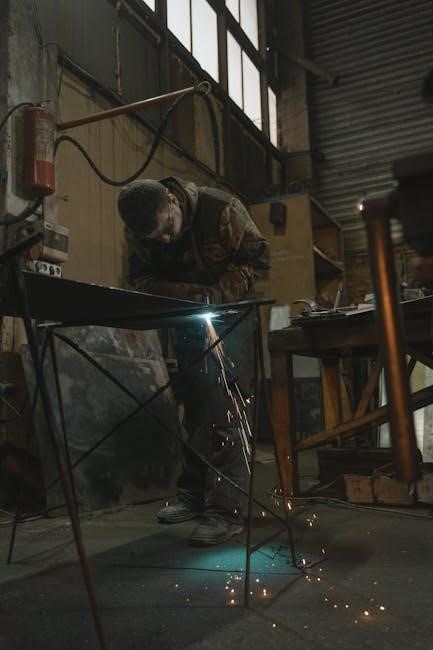
Additionally, lubricate moving parts, such as the wire feeder’s drive system, to ensure smooth operation. Use the type of lubricant recommended in the manual to prevent contamination or damage. Finally, test the welder after servicing to ensure it operates correctly. Regular servicing not only prevents unexpected breakdowns but also ensures safe and consistent welding results. By following the manufacturer’s guidelines, you can maintain your Miller welder’s optimal performance and extend its service life.
